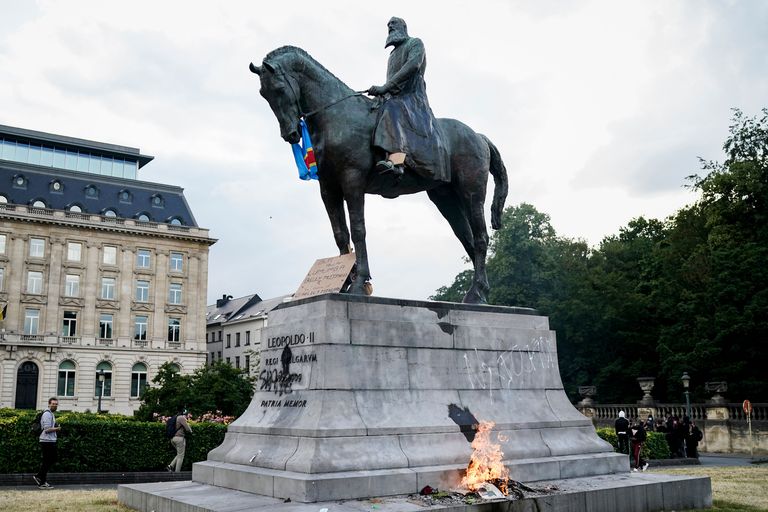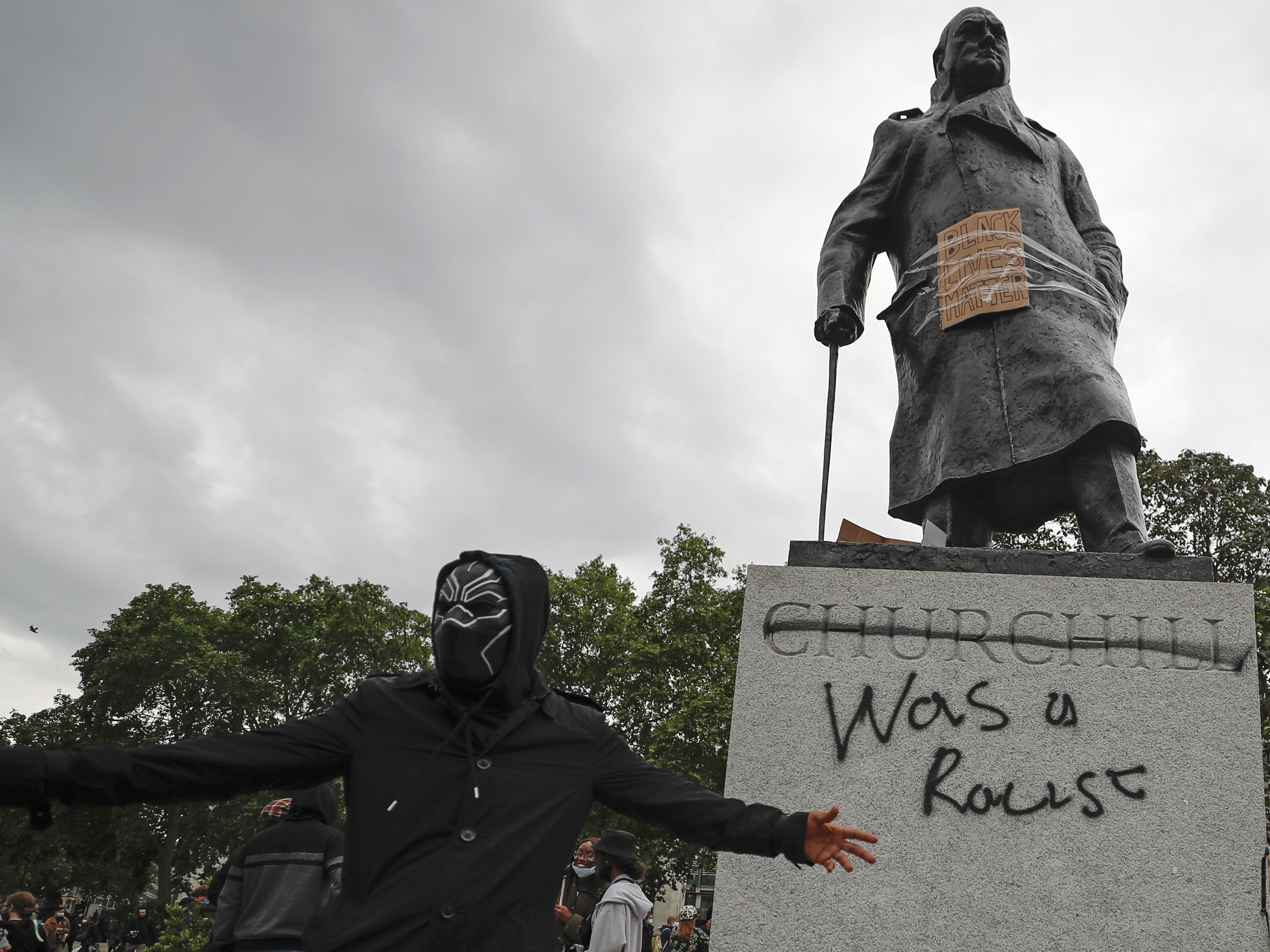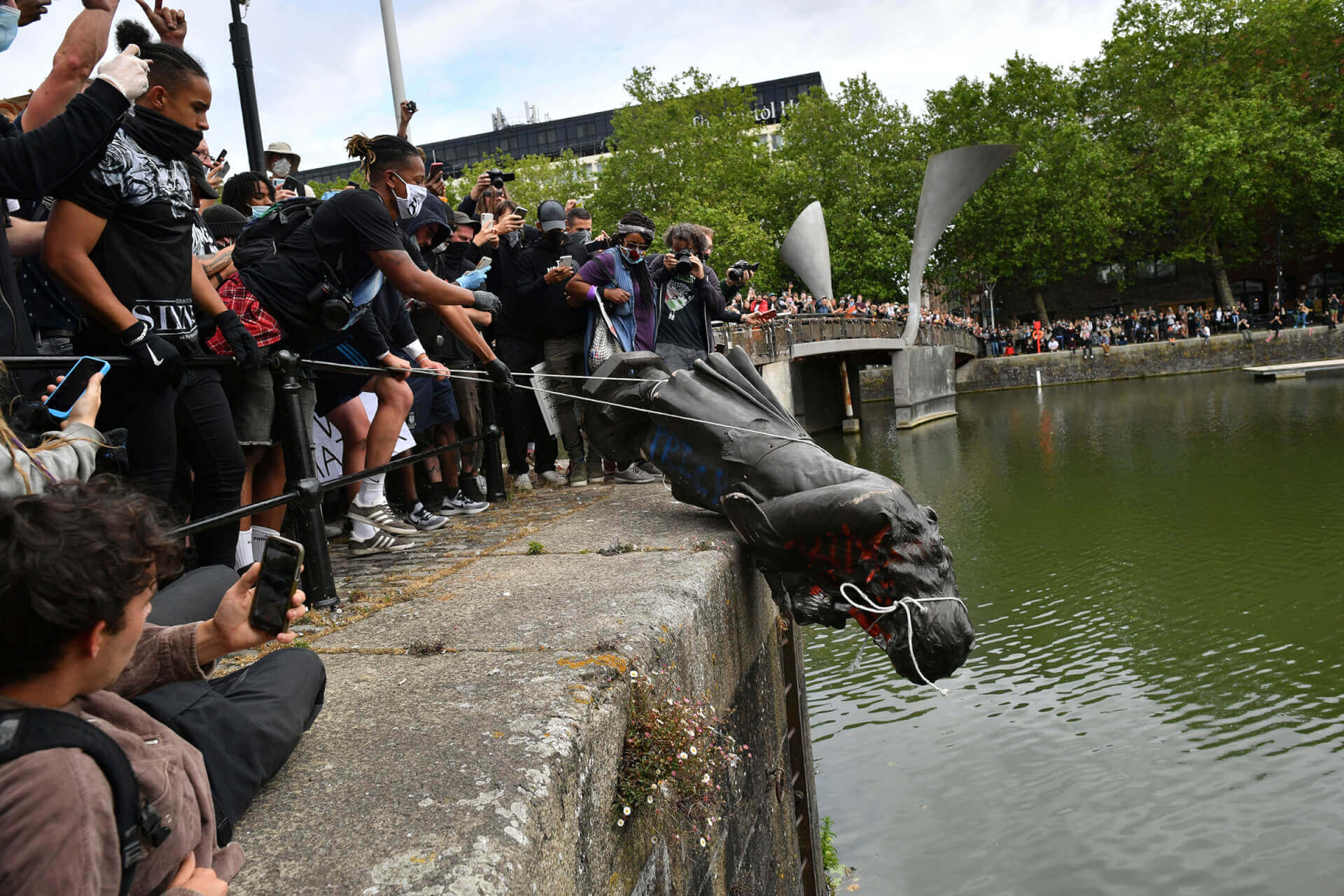The Black Lives Matter (BLM) protests have gained steam across the globe and are forcing citizens and politicians to introspect and consider which aspects of history should be on public display, and whether that display amounts to a celebration of that history or merely an acknowledgment of it. Protestors are calling for monuments of slave-traders, slave-owners, and colonialists—among other such heinous figures—to be taken down, arguing that keeping them up honors their legacy, which is built on the subjugation of marginalized communities. Their calls for the removal of these relics of the past have been met with steadfast refusal by many politicians, who counter that the removal of statues is an erasure of history, and that they aren’t celebratory monuments but tools of education and memory.
In the US, the movement to remove Confederate monuments has been going on for a few years now. The last time this movement gained such momentum was in 2017, when the removal of Confederate monuments led to the ‘Unite the Right’ protests, with White Supremacists taking to the streets to stand up for their alt-right, neo-nazi, and White nationalist ideologies.
The ongoing BLM protests have resulted in the Confederate General Robert E. Lee statue in Richmond, and a slave auction block in Fredericksburg being removed in the state of Virginia. A state of the Jacksonville Light Infantry was removed in Jacksonville, Florida, while the city's mayor, Lenny Curry, announced the removal of all Confederate monuments in the city. Similar removal announcements have also come in Indianapolis, Indiana. In some instances, protestors have taken matters into their own hands. Protestors in Virginia toppled a statue of Confederate President Jefferson Davis, while in Oregon protestors took down a statue of Thomas Jefferson. Likewise, protestors in Minnesota and in Richmond, Virginia pulled down statues of Christopher Columbus, while a statue of Columbus in Boston was beheaded.
Across the Atlantic, in London, a statue of Robert Milligan, a slave trader and plantation owner who enslaved over 500 people in Jamaica, was removed from outside the Museum of London Docklands. In fact, London Mayor Sadiq Khan has called for a review of statues in London with links to slavery, and said that such monuments should be taken down. Furthermore, confronted by years of inaction by politicians on this front, protestors in the UK have also taken down such statues themselves. For example, in Bristol, a statue of Edward Colston—a member of the Royal African Company, which transported over 80,000 Africans to the Americas—was thrown into the harbor.
In Belgium, after a statue of King Leopold II—whose colonization of the Democratic Republic of Congo was so brutal that it was even condemned by other European colonists—was torched, the government acceded to protestors’ demands by removing it from a public square in Antwerp. 
In fact, protestors in the US and the UK have devised lists of which monuments they want to be removed from public display. In the US, the list includes: The Jefferson Memorial, Statues in the Capitol, Mount Rushmore, Stone Mountain, the Albert Pike statues, and pioneer monuments. In the UK, protestors have called the removal of monuments of the following figures: Oliver Cromwell, Horatio Nelson, Sir Francis Drake, Christopher Columbus, Sir Henry de la Beche, Thomas Guy, Henry Dundas, Robert Peel, William Leverhume, Captain James Cook, Bodmin Beacon, Francis Galton, and Winston Churchill. Similar calls to remove statues of “problematic” figures are emerging all over the world. In Australia, for instance, multiple statues of Captain James Cook, a British explorer who “discovered” lands that were already populated by Indigenous communities, were defaced and vandalized.
Yet, amid this movement to cleanse the public sphere of these tributes to racism, there has been severe political pushback.
Trump, for instance, amid the 2017 Charlottesville protests, tweeted, “Sad to see the history and culture of our great country being ripped apart with the removal of our beautiful statues and monuments.” He went on to say, “You can't change history, but you can learn from it.”
Australian PM Scott Morrison has told protestors calling for the removal of Captain Cook statues to “get a grip”.
French President Emmanuel Macron has said, “The Republic won't erase any name from its history. It will forget none of its artworks, it won’t take down statues.” Macron contends that doing so risks a “hateful, false rewriting of the past”.
UK PM Boris Johnson has said he will not “photoshop”, “edit”, or “censor” history by removing monuments of historical figures, as it would “distort” or “re-write” the past.
Yet, this ignores the fact that these monuments were erected with an altogether different purpose. Several Confederate monuments in the US were erected during the early 1900s, when Jim Crow laws were being put into place. There was another surge in the construction of such monuments during the civil rights movement in the 50s and 60s. Similarly, the King Leopold II in Antwerp was erected just 50 years ago, well after people had come to understand the barbarity of his colonial rule. f
Therefore, these statues were inarguably constructed to commemorate the atrocities committed by these figures. Monuments are not textbooks, but structures to valorize historical figures and the values they stood for. Leaders like Trump speak of the “beauty that is being taken out of our cities, towns, and parks”; however, statues are not artistic marvels that are devoid of meaning, but cultural artifacts. Moreover, it is difficult to argue that they are tools of education when the remnants of the historical memories they conjure are still present in the modern-day. White nationalists are not using these statues to learn about or remind themselves of the trauma of the people their ancestors tortured, enslaved, and colonized. They are using them to celebrate what they believe to be a vital part of their culture and heritage. It is not possible to use souvenirs of our past as learning tools for our present when the legacies of yesteryear continue to haunt our lives today.
As the BLM protests have shown, Black people and indeed people of color at large continue to fight for equal rights and challenge systemic oppression even today. Moreover, the prejudices driving these inequalities are still present. Donald Trump, for instance, views armed White anti-lockdown protestors who consider the coronavirus to be a hoax as “good people”, but Black Americans demanding their rights as “thugs”. He has previously called White supremacists “very fine people”. Similarly, Mississippi Rep. Karl Oliver has said that those who destroy Confederate monuments “should be lynched”, without a lick of irony.
At the same time, why do we need a physical structure to learn our history? In Germany, for example, public Nazi imagery has been destroyed, and all Nazi symbols have been erased from Nazi-era buildings. There are no monuments or statues honoring Nazi leaders, and Germany has also buried Nazi officials in mass, unmarked graves to avoid their “resting grounds” becoming “shrines”. Has this impeded anyone’s understanding of World War II history? Has this erased Germany’s past? Ironically, the countries that still continue to maintain monuments of villainous figures, are the ones that seem to have no understanding of their history.
Australia’s PM, Scott Morrison, for instance, said Captain Cook was “no slave-trader”, adding, “He was one of the most enlightened persons on these issues you could imagine.” Morrison contends, “Australia when it was founded as a settlement, as NSW, was on the basis that there’d be no slavery.” He reaffirmed his position by saying, “It was a pretty brutal place, but there was no slavery in Australia.”
The reality is that thousands of Chinese ‘coolies’ were brought to Australia in the 1850s. Aboriginal people were enslaved for years as prostitutes and household servants. Children were stolen from Aboriginal families. At least 60,000 Pacific islanders were kidnapped to work on sugar and cotton plantations in a practice that is commonly referred to ‘blackbirding’. In fact, investigations into Australia’s blackbirding history have unearthed hundreds of unmarked graves. Some Aboriginal and Torres Strait Islanders even worked for no wage until 1972.
Prince Laurent of Belgium said of King Leopold II: “He never went to the Congo. I don't see how he could have made people suffer on the ground.”
UK PM Boris Johnson described Churchill as a “hero” and “one of the country’s greatest ever leaders”, and said that it was the “height of lunacy” to accuse him of racism. 
In truth, Churchill described colonialism as necessary to enlighten “primitive” races. He also murdered Pashtun tribesmen in Afghanistan to teach them “the superiority of the British race” in 1897; suggested bombing Irish protestors in 1920; proposed using chemical weapons against the Kurds and Indians; forced 150,000 Kenyans into concentration camps to make way for white colonialists; ordered the diversion of food supplies from “beastly” Indians that resulted in the death of 4 million in the 1943 Bengal Famine; described his role in British-run concentration camps during the Boer Wars as “great fun”; referred to Palestinians as "barbaric hordes who ate little but camel dung”; and proudly boasted of killing three “savages” in Sudan.
It is clear that the supposed lessons that these statues are meant to conjure are not being learned. So, when Trump asks, “Robert E. Lee, Stonewall Jackson – who's next, Washington, Jefferson?”, I ask: why not?
History and how it is understood forms cultural and national identities. However, when that history is littered with inaccuracies and false glorifications, is that an identity worth keeping? If monuments glorifying colonialists, despots, slave traders, and slave owners are tied to a country’s identity, then it is clear that a new national identity needs to be forged that takes into consideration the history and struggles of oppressed communities.
Yet, when this point is advanced, leaders like Macron accuse protestors of color of identifying with their own culture at the expense of national unity. On one hand, this positions the cultural identities of immigrant communities and of people of color as separate from the French identity; however, even assuming this were true, how can he expect marginalized communities to buy into an identity that is built on a celebration of their oppression?
Others, like Johnson, have used the excuse of ‘vertical relativism’, which states that ethical judgments should be informed by the cultural values and societal norms of their time. However, while people are indeed the products of their time, some ethics are universal and transcend time. For example, the moral reprehensibility of racism, colonialism, and greed are not modern concepts; they have been criticized across eras. In fact, Churchill’s own secretary of state for India, Leopold Amery, said that he saw little difference between Churchill and Adolf Hitler. Yet, one is lionized, while the other is universally vilified.
Ultimately, what is required is a distinction between the past and history. The past exists independent of our understanding of it, and cannot be changed. History, however, and the cultural tools that come with it, is always incomplete, and will forever be re-written to incorporate new information. In a world where our understanding of history is incomplete or willfully ignored, and where the legacy of our past continues to torment our present, monuments of controversial figures belong in a museum, where they can be used as the educational tools they are argued to be, rather than on our streets. The damage wrought by these individuals and the values they stood for is not lost on the protestors demanding their removal. They do not need a reminder of a history whose effects they continue to experience even to this day.
Monuments Aren’t Educational Tools. Why Pretend Otherwise?
Monuments valorize historical figures and the values they stood for.
June 20, 2020

IMAGE SOURCE: PA IMAGES / ALAMY STOCK PHOTOA statue of slave-trader Edward Colston was thrown into the Bristol harbor.
